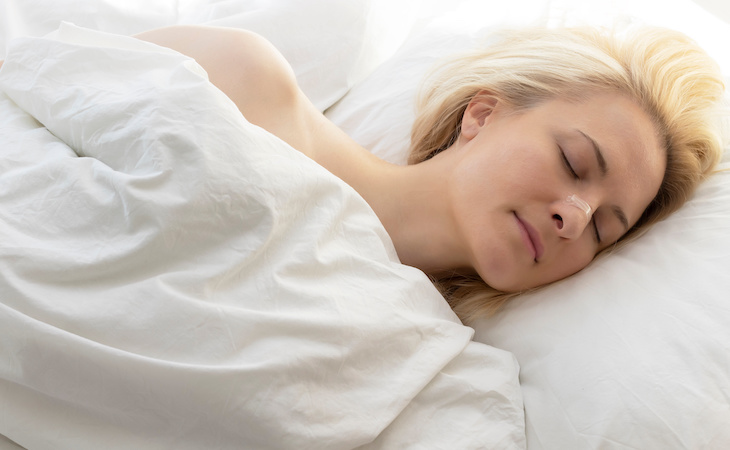If you’ve had issues with snoring or sleep apnea, then you’ve probably noticed the shelf of nasal strips at your local drugstore. These simple, drug-free adhesives are designed to open your airways so you can breathe through your nose overnight.
But is there any research to support nasal strips for better sleep? And what do doctors have to say about using nasal strips for sleep apnea?
Here’s what you need to know about how effective nasal strips are in helping to manage sleep apnea and other sleep issues.
How do nasal strips work?
Nasal strips are semi-flexible adhesive bands that you apply across the bridge of your nose and the sides of your nostrils. The strips’ natural propensity to straighten pulls the nostrils open.
“Nasal strips help by improving nasal airflow in one part of the nasal cavity called the nasal valve, which is the part of the nose that is the narrowest area and can have restriction of airflow,” says Gregory Smith, MD, an ear nose and throat doctor at NJ ENT & Facial Plastic Surgery.
Ultimately, nasal strips expand the breathing area so that more air can flow in and out of the nostrils.
“Nasal strips help by improving nasal airflow in one part of the nasal cavity called the nasal valve, which is the part of the nose that is the narrowest area and can have restriction of airflow.”
Gregory Smith, MD, an ear nose and throat doctor at NJ ENT & Facial Plastic Surgery
Are nasal strips good for sleep apnea?
Nasal strips aren’t an official, FDA-approved treatment for sleep apnea. But that doesn’t mean they can’t help improve symptoms of this sleep disorder.
Research shows that mouth breathing narrows the airway, increasing the likelihood and frequency of breathing cessation associated with obstructive sleep apnea.
So, anything that promotes nasal breathing over mouth breathing is good for sleep apnea. Ultimately, nasal strips help you comfortably breathe through your nose.
“For some patients, improving nasal airflow can be both an assistance and eventually a cure if they can retrain themselves to breathe appropriately through their nose,” says Smith.
How to use nasal strips for sleep apnea
Nasal strips are meant to be used at night. Using them is as simple as applying them before bed and removing them after you wake up.
Avoid wearing them for more than 12 hours at a time as prolonged use can diminish the adhesive’s effectiveness and irritate the skin of your nose, according to Smith.
Best nasal strips for sleep apnea
Breathe Right is the most commonly recommended nasal strip brand by experts like Smith. He says “store brand versions” of Breathe Right have similar effectiveness.
In the end, nasal strips all have similar designs. If you’re using nasal strips to improve sleep apnea symptoms, the best strip is the one that feels most comfortable to you.
Aside from Breathe Right, popular brands include Clear Passage, InstaClear, and Vicks ZzzQuil.
Other sleep apnea treatment options
If you struggle to get a good night’s rest, then the first step is to talk to your doctor or a sleep specialist. A sleep study may be necessary to diagnose sleep apnea.
Once diagnosed with sleep apnea, it’s essential to follow your doctor’s instructions. Sleep apnea treatment often involves lifestyle changes such as changing sleep positioning, regular exercise, and maintaining a healthy weight.
Other sleep apnea treatments include:
- Breathing devices. A continuous positive airway pressure (CPAP) machine is one of the most common sleep apnea treatments. other breathing devices include an adjusting positive airway pressure (APAP) machine or a bilevel positive airway pressure (BPAP) machine.
- Oral devices. “Oral appliances help pull the jaw and tongue forward to improve mouth positioning,” says Smith. These devices are typically custom-fit by a dentist.
- Mouth taping. “There’s no great evidence-based medicine that suggests that mouth taping is beneficial,” says Smith. However, he says mouth taping in conjunction with mouth positioning retraining can be helpful for some patients who have adequate nasal airflow.
- Minimally invasive procedures. Smith says an ear, nose, and throat (ENT) doctor may prescribe an in-office procedure that relieves nasal obstructions by reshaping tissue and cartilage inside the nose.
- eXciteOSA. This user-controlled neuromuscular electrical stimulator is a daytime sleep apnea treatment. “It’s basically used to help retrain the tongue and mouth positions for patients with sleep apnea,” says Smith. “It’s typically prescribed by an ENT or a sleep physician.”
FAQs
Will nose strips help sleep apnea?
Maybe, but the effectiveness depends on the severity and cause of your sleep apnea. “Nasal strips can significantly improve someone’s breathing, which can have downstream positive impacts on sleep and sleep apnea,” says Smith.
However, he tells his patients that this isn’t a one-size-fits-all problem. “Someone’s problems may be the internal nasal valve and nasal breathing, someone else’s problem may be a deviated septum,” says Smith.
Can you use nasal strips every night?
Yes, you can use nasal strips every night if the adhesive does not cause skin irritation. If you notice redness, itchiness, or inflammation on the bridge of your nose, then skip the strips until the irritation subsides.
What works better than nasal strips?
Nasal strips make it easier to breathe through your nose, but they haven’t been proven as an effective treatment for obstructive sleep apnea. The main treatment for sleep apnea is a CPAP machine. Evidence-based treatments such as CPAP, appliance therapy, and surgery work better than nasal strips.




